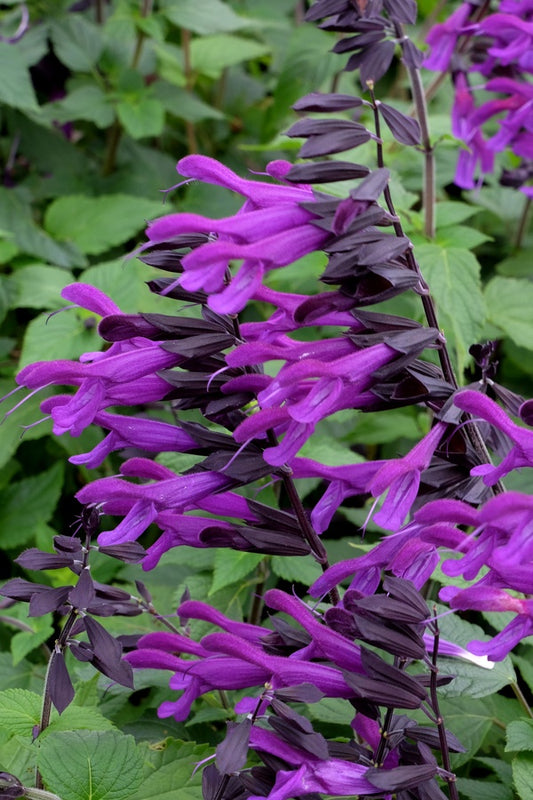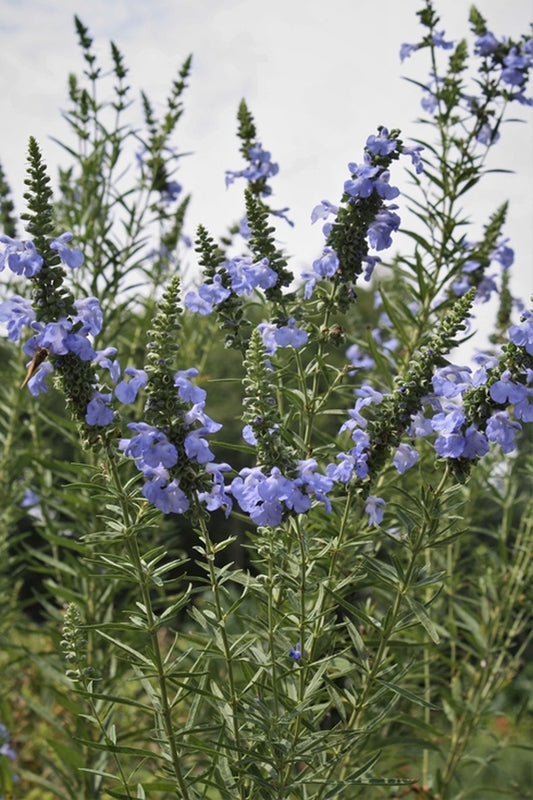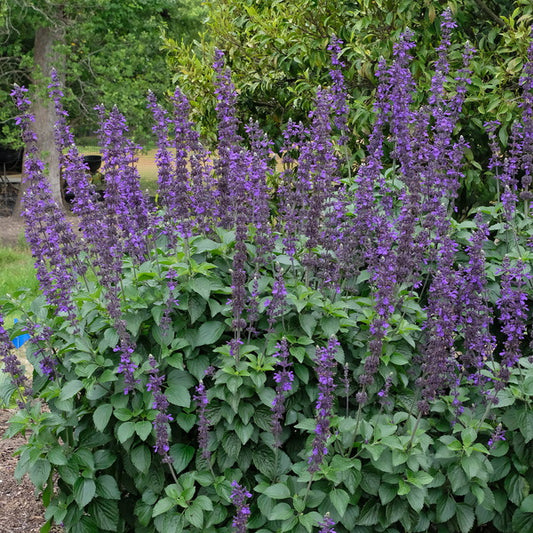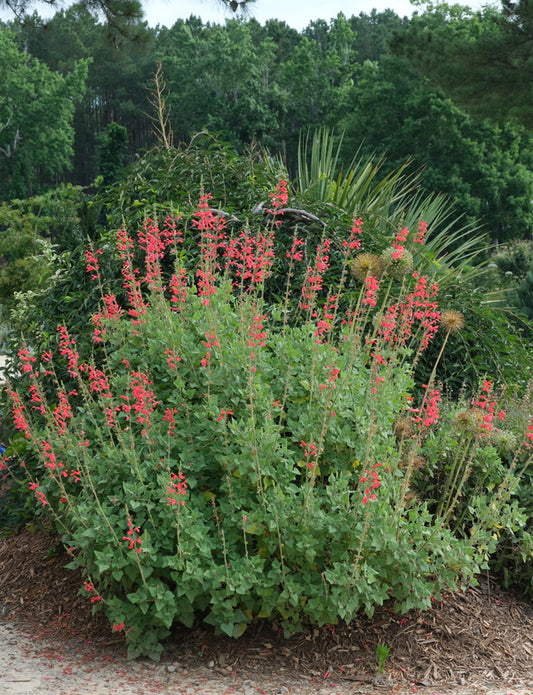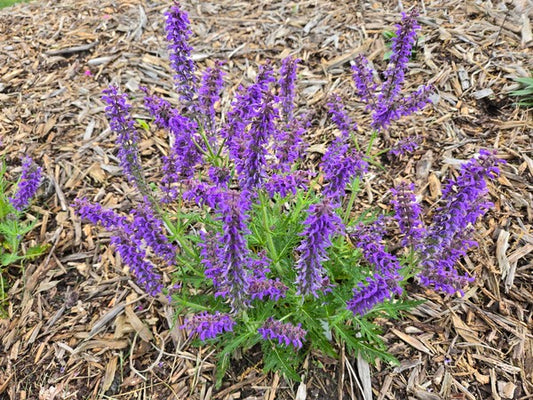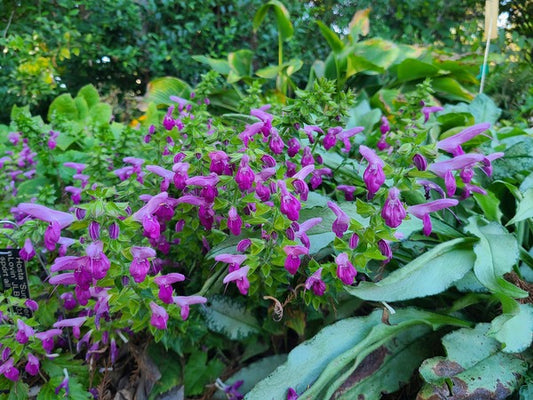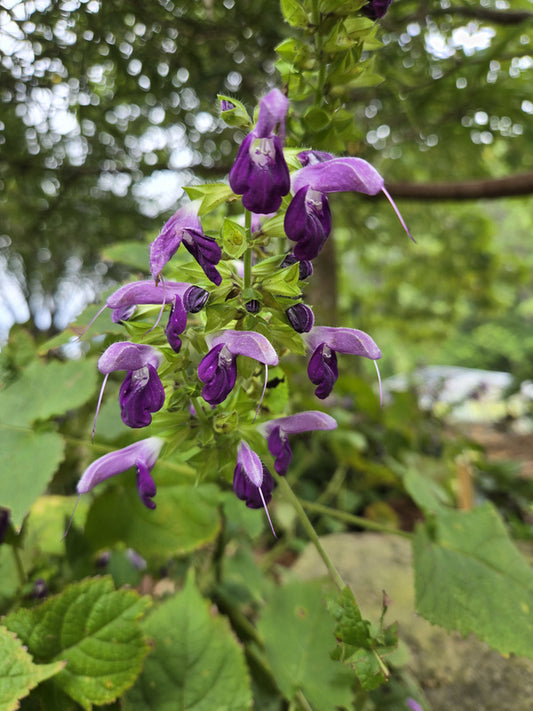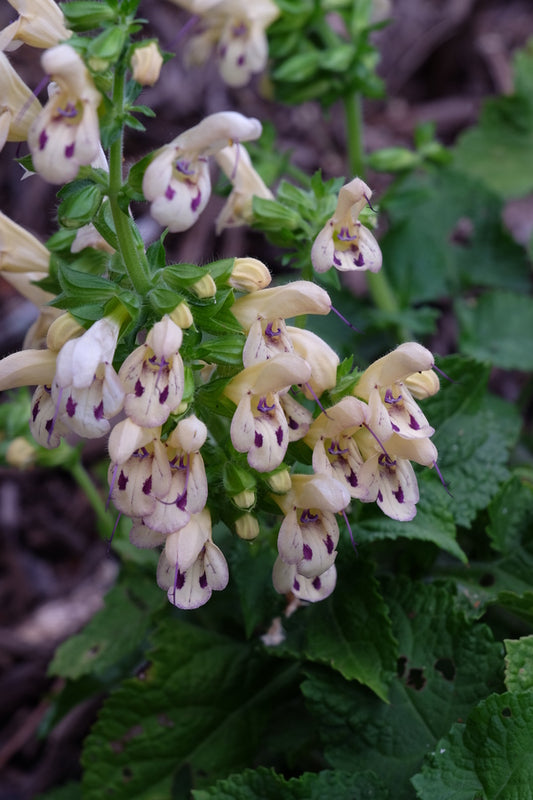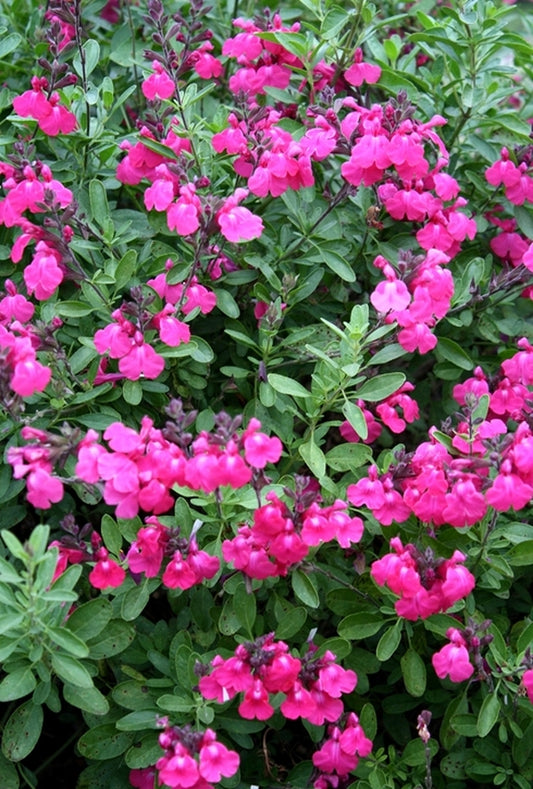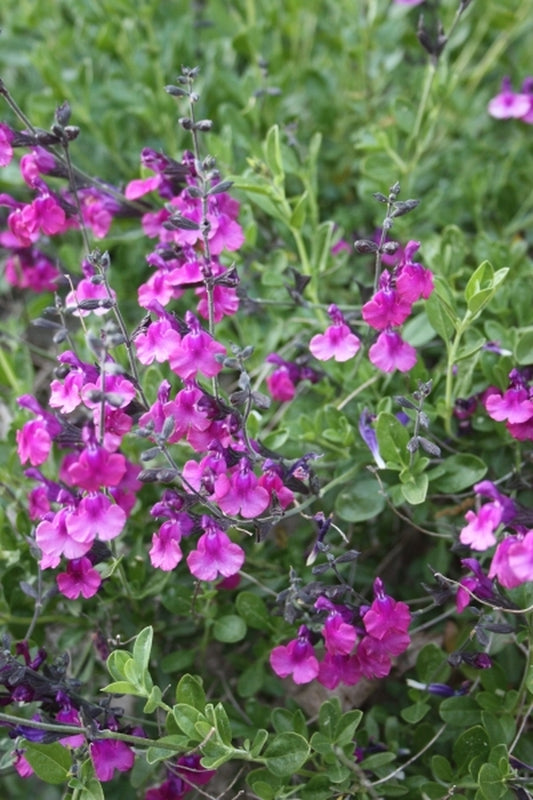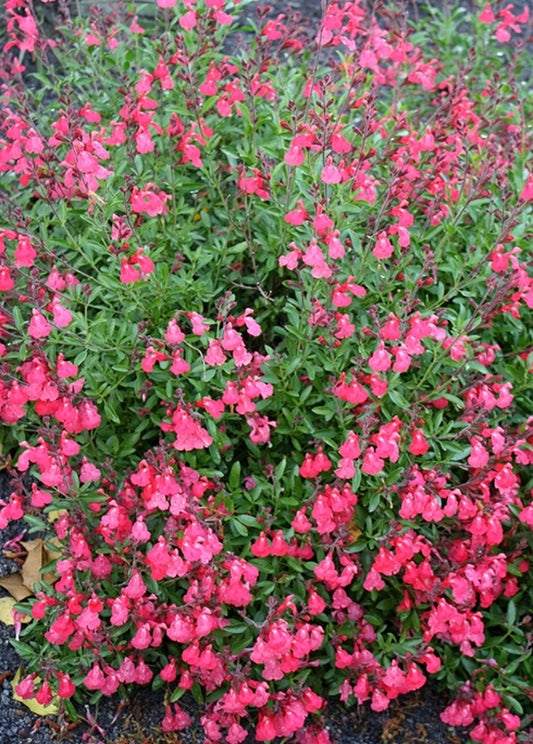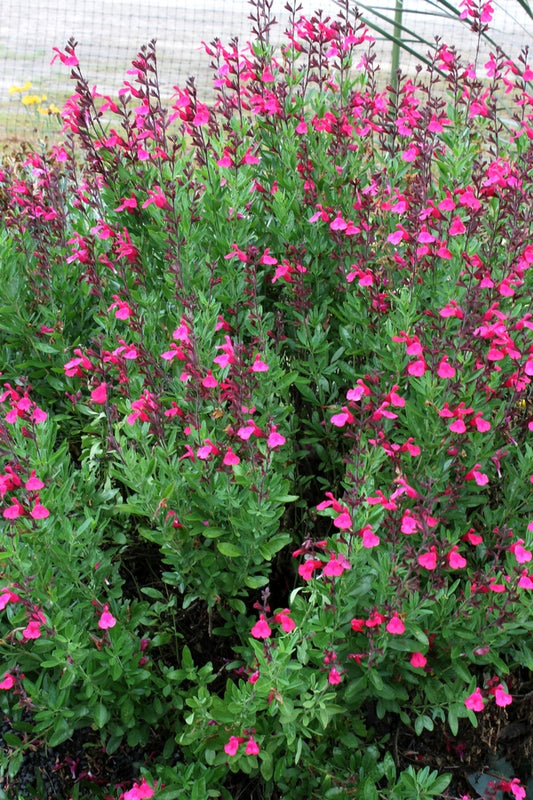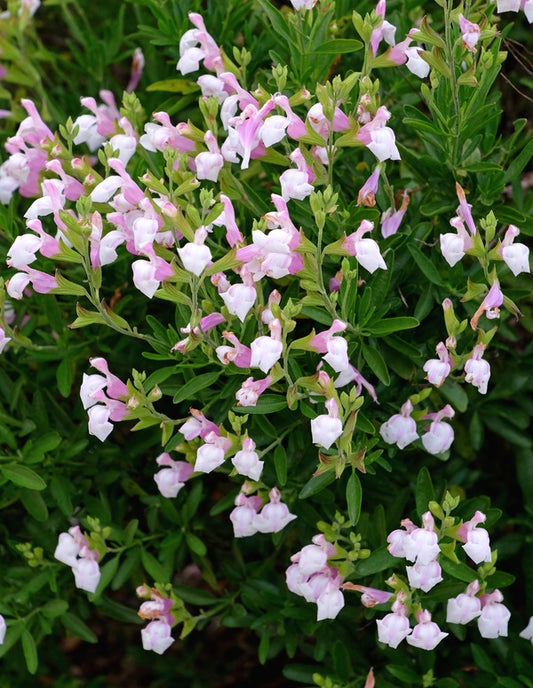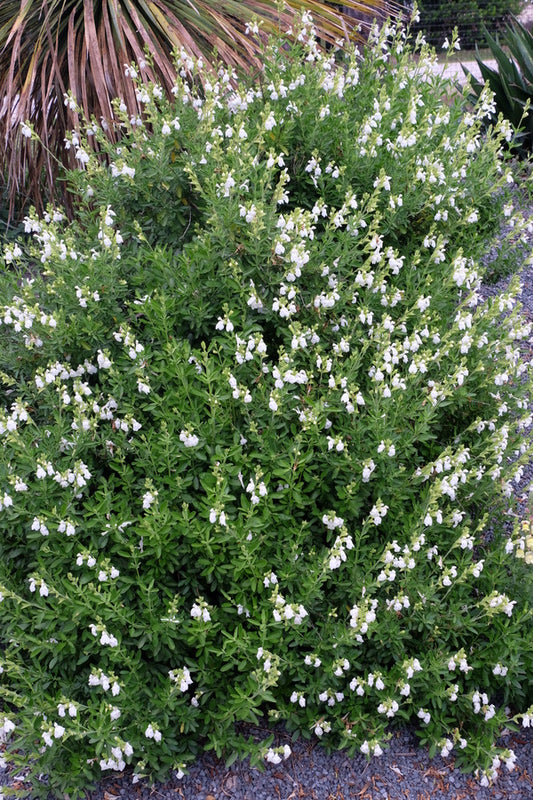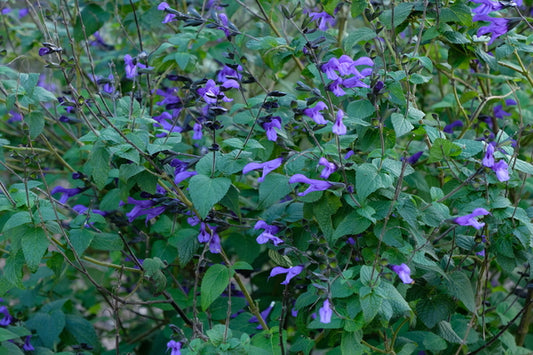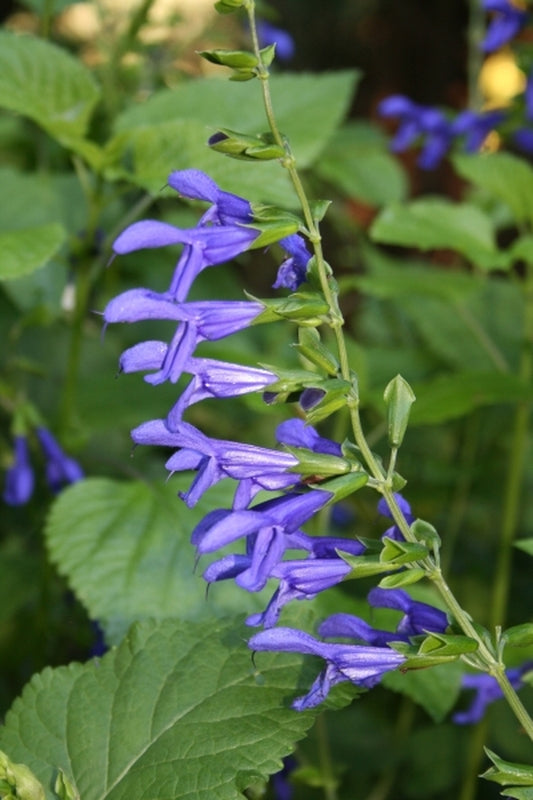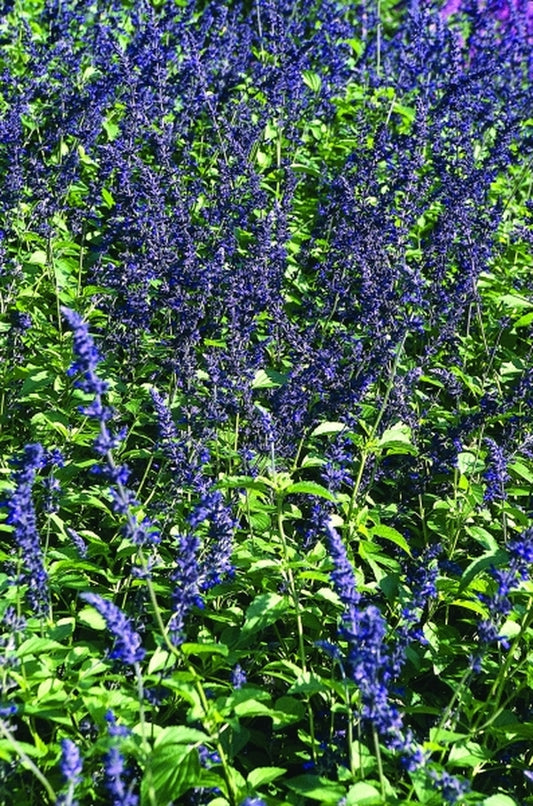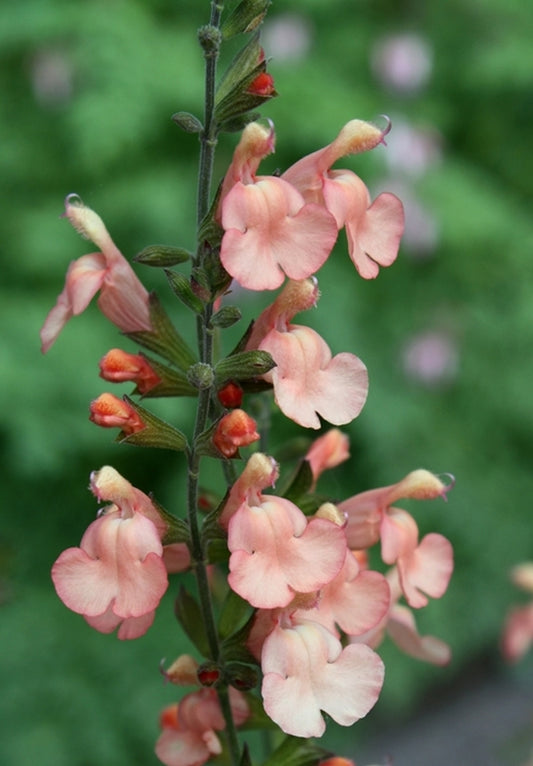Plant Delights brings you the latest and the best of new woody and perennial salvia, including many American native plants like Salvia greggii, Salvia farinacea, and Salvia microphylla, from the Southwest US and Mexico, plus South American natives such as Salvia guaranitica and European natives such as Salvia nemorosa and Salvia sylvestris.
-
Salvia 'Amistad' PP 23,578
Item #: 6611
Zones: 8a to 10b
Dormancy: Winter
Height: 42" tall
Culture: Sun
Origin: Hybrid
Pot Size: 3.5" pot (24 fl. oz/0.7 L)
Regular price $22.00Regular priceUnit price per -
Salvia azurea 'Little Boy Blue'
Item #: 10547
Zones: 4a to 8b
Dormancy: Winter
Height: 48" tall
Culture: Sun
Origin: United States
Pot Size: 3.5" pot (24 fl. oz/0.7 L)
Regular price $21.00Regular priceUnit price per -
Salvia 'Big Blue'
Item #: 16696
Zones: 7b to 10b
Dormancy: Winter
Height: 48" tall
Culture: Sun to Part Sun
Origin: Hybrid
Pot Size: 3.5" pot (24 fl. oz/0.7 L)
Regular price $21.00Regular priceUnit price per -
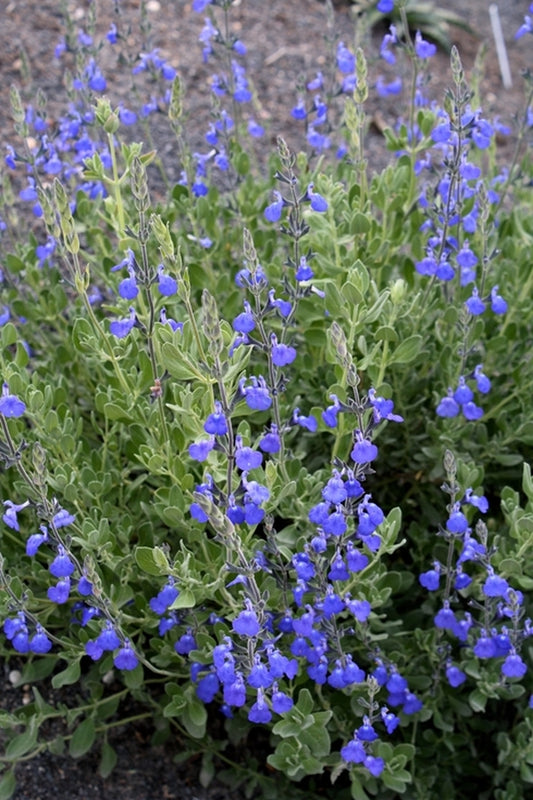 Sold out
Sold outSalvia chamaedryoides
Item #: 688
Zones: 7a to 10b
Dormancy: Evergreen
Height: 18" tall
Culture: Sun to Part Sun
Origin: Mexico
Pot Size: 3.5" pot (24 fl. oz/0.7 L)
Regular price $22.00Regular priceUnit price per -
Salvia darcyi 'Presidio'
Item #: 17484
Zones: 6a to 10b, possibly colder
Dormancy: Winter
Height: 54" tall
Culture: Sun to Part Sun
Origin: Mexico
Pot Size: 3.5" pot (24 fl. oz/0.7 L)
Regular price $22.00Regular priceUnit price per -
 Sold out
Sold outSalvia farinacea 'Augusta Duelberg'
Item #: 6823
Zones: 7b to 9b, at least
Dormancy: Winter
Height: 30" tall
Culture: Sun
Origin: United States
Pot Size: 3.5" pot (24 fl. oz/0.7 L)
Regular price $21.00Regular priceUnit price per -
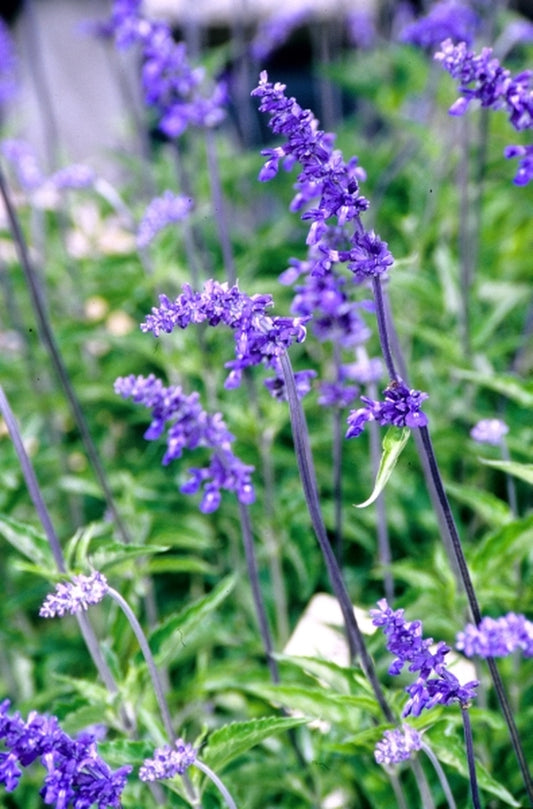 Sold out
Sold outSalvia farinacea 'Henry Duelberg'
Item #: 6822
Zones: 7b to 9b, at least
Dormancy: Winter
Height: 36" tall
Culture: Sun
Origin: United States
Pot Size: 3.5" pot (24 fl. oz/0.7 L)
Regular price $21.00Regular priceUnit price per -
Salvia 'Feathers Peacock' PP 33,993
Item #: 18547
Zones: 4a to 8a
Dormancy: Evergreen
Height: 16" tall
Culture: Sun to Part Sun
Origin: Hybrid
Pot Size: 3.5" pot (24 fl. oz/0.7 L)
Regular price $21.00Regular priceUnit price per -
Salvia glabrescens 'Autumn Enchanter'
Item #: 17041
Zones: 5b to 8b
Dormancy: Winter
Height: 30" tall
Culture: Part Sun to Light Shade
Origin: Japan
Pot Size: 3.5" pot (24 fl. oz/0.7 L)
Regular price $22.00Regular priceUnit price per -
Salvia glabrescens 'Autumn Equinox'
Item #: 15303
Zones: 5b to 8b
Dormancy: Winter
Height: 24" tall
Culture: Part Sun to Light Shade
Origin: Japan
Pot Size: 3.5" pot (24 fl. oz/0.7 L)
Regular price $22.00Regular priceUnit price per -
Salvia glabrescens 'Elk Yellow & Purple'
Item #: 11050
Zones: 5b to 8b
Dormancy: Winter
Height: 18" tall
Culture: Part Sun to Light Shade
Origin: Japan
Pot Size: 3.5" pot (24 fl. oz/0.7 L)
Regular price $22.00Regular priceUnit price per -
Salvia greggii 'Big Pink'
Item #: 2615
Zones: 7a to 10b, possibly colder
Dormancy: Evergreen
Height: 40" tall
Culture: Sun to Part Sun
Origin: Mexico
Pot Size: 3.5" pot (24 fl. oz/0.7 L)
Regular price $22.00Regular priceUnit price per -
Salvia greggii 'Diane'
Item #: 5082
Zones: 7a to 9b, at least
Dormancy: Evergreen
Height: 18" tall
Culture: Sun
Origin: Mexico, United States
Pot Size: 3.5" pot (24 fl. oz/0.7 L)
Regular price $22.00Regular priceUnit price per -
Salvia greggii 'Lipstick'
Item #: 3202
Zones: 7a to 10b
Dormancy: Evergreen
Height: 36" tall
Culture: Sun to Part Sun
Origin: United States
Pot Size: 3.5" pot (24 fl. oz/0.7 L)
Regular price $22.00Regular priceUnit price per -
Salvia greggii 'Pink Preference'
Item #: 5042
Zones: 6a to 10b
Dormancy: Evergreen
Height: 24" tall
Culture: Sun to Part Sun
Origin: United States
Pot Size: 3.5" pot (24 fl. oz/0.7 L)
Regular price $22.00Regular priceUnit price per -
Salvia greggii 'Teresa'
Item #: 7195
Zones: 7a to 9b, at least
Dormancy: Evergreen
Height: 36" tall
Culture: Sun
Origin: United States
Pot Size: 3.5" pot (24 fl. oz/0.7 L)
Regular price $22.00Regular priceUnit price per -
Salvia greggii 'Texas Wedding'
Item #: 889
Zones: 5b to 10b, at least
Dormancy: Evergreen
Height: 24" tall
Culture: Sun to Part Sun
Origin: United States
Pot Size: 3.5" pot (24 fl. oz/0.7 L)
Regular price $22.00Regular priceUnit price per -
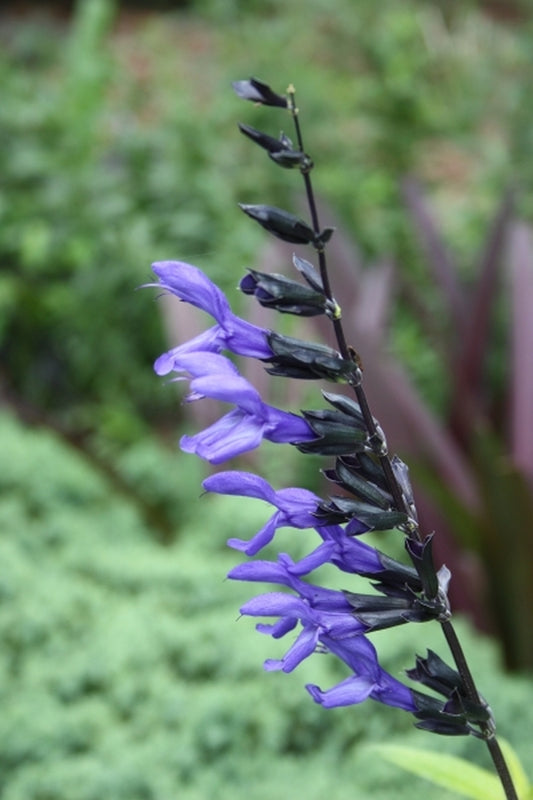 Sold out
Sold outSalvia guaranitica 'Black and Blue'
Item #: 2016
Zones: 7a to 10b
Dormancy: Winter
Height: 36" tall
Culture: Sun to Part Sun
Origin: Brazil
Pot Size: 3.5" pot (24 fl. oz/0.7 L)
Regular price $21.00Regular priceUnit price per -
Salvia guaranitica 'Rhythm and Blues' PP 29,585
Item #: 14827
Zones: 7a to 10b
Dormancy: Winter
Height: 36" tall
Culture: Sun to Part Sun
Origin: Brazil
Pot Size: 3.5" pot (24 fl. oz/0.7 L)
Regular price $21.00Regular priceUnit price per -
Salvia guaranitica 'Van Remsen'
Item #: 8363
Zones: 7a to 10b, at least
Dormancy: Winter
Height: 84" tall
Culture: Sun
Origin: Argentina, Brazil
Pot Size: 3.5" pot (24 fl. oz/0.7 L)
Regular price $21.00Regular priceUnit price per -
 Sold out
Sold outSalvia hierosolymitana
Item #: 13616
Zones: 7b to 10b, at least
Dormancy: Winter
Height: 24" tall
Culture: Sun to Part Sun
Origin: Cyprus, Israel, Lebanon, Mediterranean Europe, Syria
Pot Size: 3.5" pot (24 fl. oz/0.7 L)
Regular price $21.00Regular priceUnit price per -
Salvia 'Indigo Spires'
Item #: 901
Zones: 7b to 10b
Dormancy: Winter
Height: 36" tall
Culture: Sun to Part Sun
Origin: Hybrid
Pot Size: 3.5" pot (24 fl. oz/0.7 L)
Regular price $21.00Regular priceUnit price per -
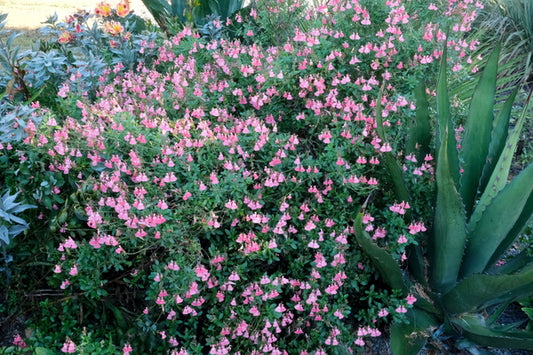 Sold out
Sold outSalvia x jamensis 'Blast' PP 24,153
Item #: 9868
Zones: 7a to 9b, at least
Dormancy: Evergreen
Height: 48" tall
Culture: Sun to Part Sun
Origin: United States Hybrid
Pot Size: 3.5" pot (24 fl. oz/0.7 L)
Regular price $22.00Regular priceUnit price per -
Salvia x jamensis 'California Sunset'
Item #: 5952
Zones: 7b to 9b, at least
Dormancy: Evergreen
Height: 36" tall
Culture: Sun
Origin: Hybrid
Pot Size: 3.5" pot (24 fl. oz/0.7 L)
Regular price $22.00Regular priceUnit price per
More Information About Salvia
Many beginning gardeners assume that salvia species are all annuals... when in fact, perennial salvia are the majority. Thanks to the efforts of NC's resident salvia expert, Richard Dufresne, and many others, perennial sages in the genus salvia have become much more popular.
Our goal is to bring you the latest and the best of new woody and perennial salvia, including many American native plants like Salvia greggii, Salvia farinacea, and Salvia microphylla, from the Southwest US and Mexico, plus South American natives such as Salvia guaranitica and European natives such as Salvia nemorosa and Salvia sylvestris.
Perennial salvia flowers come in a wide range of colors. There are red, pink, salmon, coral, orange, yellow, purple, white, blue salvias and everything between. There are dozens of perennial salvia species and cultivars to choose from, each with a slightly different flower color. While salvia flowers attract butterflies and hummingbirds to the garden, they are generally not browsed by deer or rabbits. Their low maintenance requirements and tough nature make Salvia perfect for rain gardens, containers, or patio gardens.
How To Grow Salvia
-
As a group most perennial salvias prefer full bright sun and well-drained soil, although a few are shade plants.
-
Once established, many perennial salvias are quite drought tolerant.
-
As a general rule, salvias like very well drained soil...they are mostly rock-garden type plants.
-
For many of the marginally hardy perennial salvias, we recommend they not be cut back until early spring, since water will fill cut branches and freeze in winter, killing the plant.
Types of Salvia
Salvia greggii and Salvia microphylla are two of the most popular woody perennial salvia species for sale, each available in a range of colors. Salvia nemorosa is the most popular of the perennial salvia species, in part because of its wide range of hardiness. Many other perennial salvias are only winter-hardy in the mid- or deep- South. The tall, blue Salvia guaranitica is a popular perennial sage, particularly the bicolor clone Salvia Black and Blue.
Salvia greggii is an American native plant from Texas and Mexico that is very popular in the southwest due to its aromatic leaves (somewhat minty) and colorful flowers on the red end of the spectrum. Salvia greggii is relatively carefree and very tough...perfect for a low maintenance garden. It resents too much fertilizer and irrigation but does not mind regular pruning to enhance its shape. Salvia greggii is a Texas native plant that is named in honor of a Tennessean named Josiah Gregg who botanized the southwest in the 1840's. In addition to enjoying Salvia greggii in the garden for its colorful flowers and shrubby habit, try using the leaves in potpourri or as a seasoning. Salvia greggii frequently hybridizes with Salvia microphylla and the resultant offspring are referred to as 'Salvia greggii types' or Salvia x jamensis. At the southern end of its hardiness range Salvia greggii is evergreen but a the northern end, it will freeze to the ground.
The European native, Salvia nemorosa, is very popular 'across the pond' where they have done extensive breeding and hybridization work...especially with its nemorosa x pratensis hybrid called Salvia x sylvestris. Here in the US we have adopted some immigrant Salvia nemorosa cultivars into our gardens as well. Medicinally, Salvia nemorosa leaves are used as bandages to staunch bleeding due to the blood clotting ability of nemorone and other compounds. Salvia nemorosa flowers tend to be on the blue/purple end of the spectrum and form long spikes above the foliage which not only look good in the garden, but also make great cut flowers. Plus, cutting the flowers, stimulates Salvia nemorosa to make even more flowers. Win-win!
Salvia nemorosa is commonly hybridized with other species such as S. pratensis and the crosses are referred to as Salvia x sylvestris, which is sometimes shortened to Salvia sylvestris. Like its parents, Salvia sylvestris tends to produce spiky purple to blue salvia flowers end of the spectrum. One such cultivar, 'May Night' won the PPOY award in 1997. Another popular S. sylvestris is 'Caradonna'.
We grow a very large selection of perennial salvias for sale, so when you're ready to buy salvia plants for your perennial garden, we hope you'll check our our online list of salvia plants for sale at Plant Delights.
Additional Salvia Resources:
JLBG Collection Contains: 52 Species, 275 unique clones and 1 nothospecies
For additional information about salvia plants, read our in depth article about perennial salvia and this article about different varieties of blue salvia. Also, be sure to check out our many blog posts about salvia over at our Juniper Level Botanic Gardens blog.


